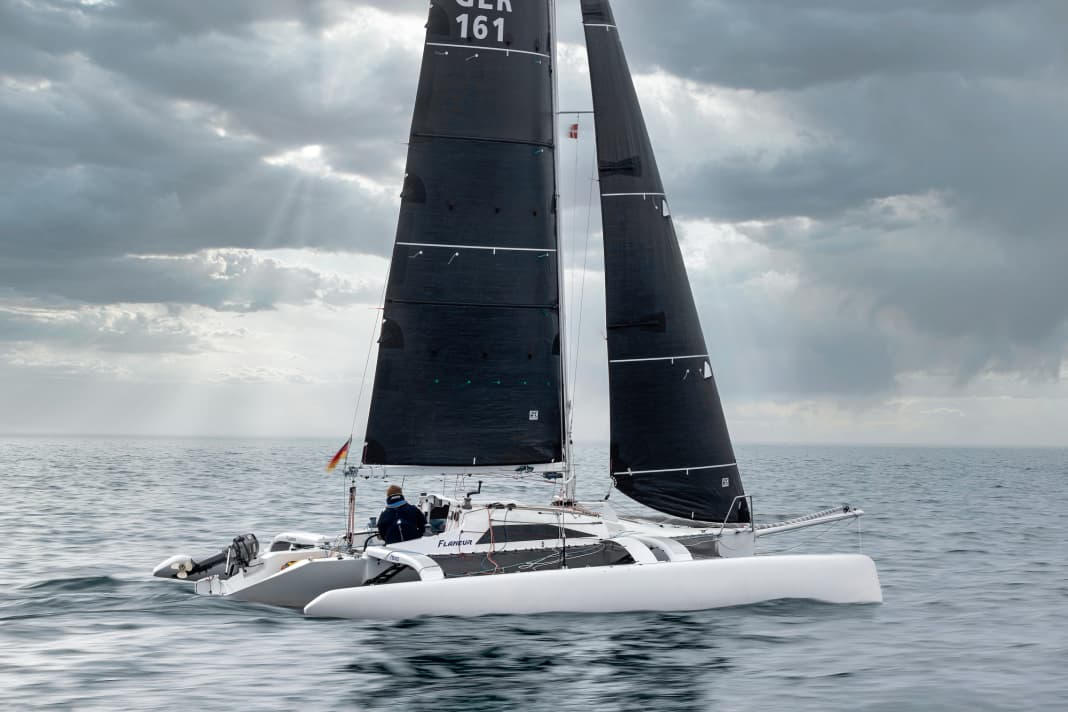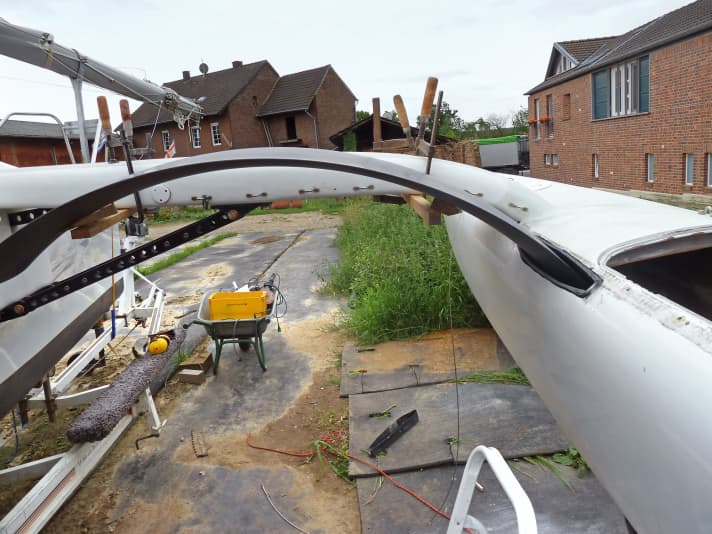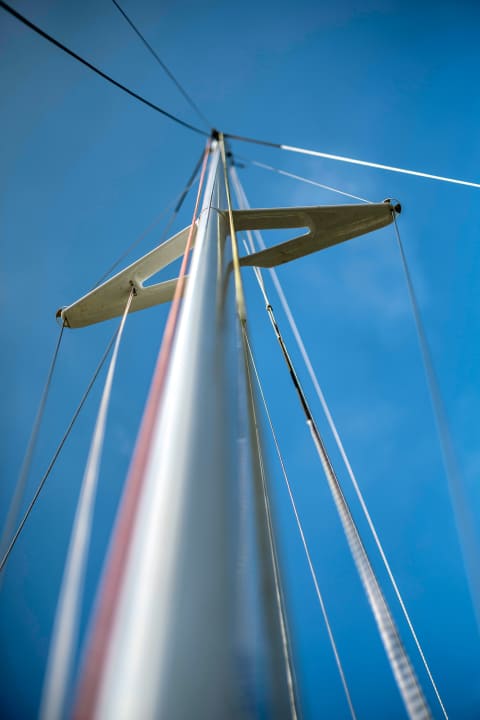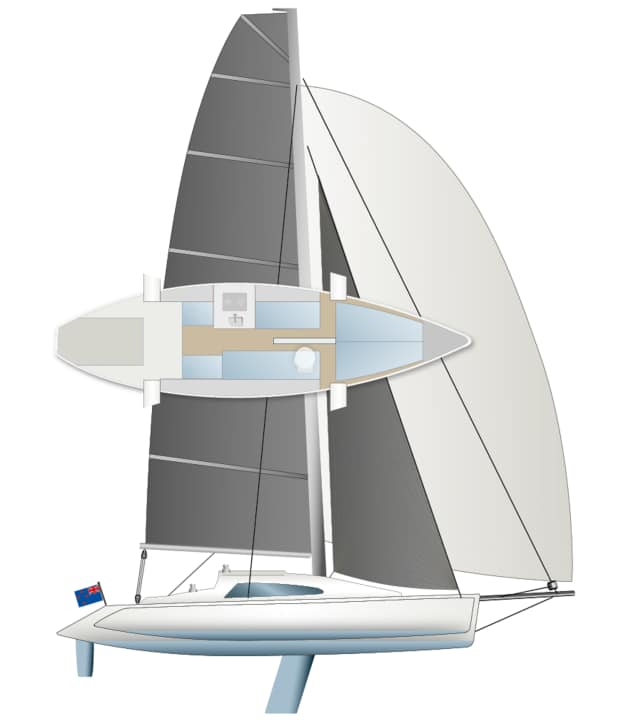





- Multihulls can easily reach speeds greater than that of the true wind
- One suspects that "Flaneur" is subject to greater forces than a standard trimaran
- "Flaneur" is an extremely fast-paced boat of manageable size and budget
- Bätz and "Flaneur" - a kind of sailing symbiosis
- Swimmers now only weigh 52 kilograms each
- Big goal: Silverrudder
- Simple and functional interior on the "Flaneur"
- "Flaneur" hunts for titles
- The foils: high-tech meets do it yourself
- The mast: self-laminated without moulds
- Technical data of the "Flaneur"
What characterises a 27.5-foot trimaran and makes it a boat worth looking at? Its sailing characteristics, which have been improved after numerous modifications, its owner, who boldly and creatively tackles the most demanding challenges in boat building, or the fact that he even sails 900 nautical miles of ocean racing alone with the tuned version? André Bätz not only redesigned the rudder, centreboard and side hulls of the "Flaneur" and built a new carbon fibre mast, but also integrated two large foils in both floats - first in the old ones and then in the new, self-made carbon ones.
According to Bätz, there is a clearly positive effect from a speed of around ten knots, with an increase in speed of a full two to four knots, depending on the course. On the wind, the foils are only half extended. "This allows you to sail about three to five degrees higher upwind, which is difficult to estimate," says Bätz. On a half-wind course and at around 4 Beaufort, 20 knots are now possible. Depending on the angle setting of the foil, the bow of the lee side hull lifts almost completely out of the water, which also significantly reduces the risk of chop and makes the boat not only significantly faster, but also safer.
Multihulls can easily reach speeds greater than that of the true wind
Test drive with Bätz's version 3.0 of his "Flaneur" not far from Svendborg shortly before the world's biggest single-handed race, the Silverrudder, in which the hobby boat builder will be competing. We glide almost silently through the water in the early morning mist with the tri, even though all three bows are pulling through the water. We almost float, small waves splashing gently against the side hulls. A large, circularly curved foil protrudes from each of them. The sun slowly works its way through the fog on this pleasant morning. The beautiful late summer has warmed the water once again, the previous starry night has set its cool air against it, wafts of mist waft between Gelting and Sønderborg. The black sails go well with the grey of the air, everything looks like a black and white film. The mainsail is perfectly positioned on the gleaming white rotating wing mast, and although there is hardly any wind, the small trimaran accelerates effortlessly to seven to eight knots.
The extended tiller sits comfortably in the hand and the "Flaneur" reacts to the slightest impulse. So that André Bätz, the single-handed pilot from the Rhineland, can utilise all the freedom for trimming, navigating and resting, the push rod of the Raymarine autopilot is stored in a kind of oarlock within easy reach next to his knee and can be easily disengaged and clicked into the tiller. Due to the rotating mast, the autopilot does not sail according to apparent or true wind, but according to the compass.
In order to keep the current on the sails alive at relatively high speeds, the helmsman must act very sensitively and constantly compensate. This is the only way for the tri to create its own wind, build up speed and maintain it. Multihulls can easily reach speeds that are greater than those of the true wind. The prerequisites for this are low resistance, low weight and sufficient sail area. The high dimensional stability of a tri combined with low weight and low water resistance gives it wings.
One suspects that "Flaneur" is subject to greater forces than a standard trimaran
From the very beginning, André Bätz's aim was to find the optimal device with plenty of potential for tuning. The initial idea and the arduous purchasing process were followed by many adventures in challenging regattas such as the Silverrudder or the Midsummersail, which the engineer tackled with little experience but plenty of courage.
Bätz started his sailing career at the age of five, but the namesake for his trimaran project, the then "Flaneur", was a heavy cabin cruiser that his father had built for excursions on the Lower Rhine. For Bätz, it was the initial experience and the greatest incentive to do it better and faster at some point. Bätz's wife treats him to his four trips a year, "I call it the family singularity", and the grown-up children also join him from time to time, but it is usually too wet and too spartan for them.
Bätz uses a trim line to adjust the self-built rotating mast to an optimum angle of rotation, the angle relative to the boom, depending on the course, until the trim lines on both sides of the mainsail are in perfect contact. This acts like an accelerator pedal. "With the mast angle, I can also reef in reverse, so to speak." As a process technician and engineer with a penchant for fluid mechanics, Bätz knows what the profile of a sail should be. The mainsheet tackle is very strong for a 27.5-foot boat. You can guess that greater forces are at work here than on a standard trimaran or monohull. To avoid a so-called plug or even capsizing, it can be opened easily with a jerk upwards, even under pressure. This is important in parallel with controlled dropping in order to quickly release the pressure from the sail in an emergency. Further forward on the boom is a device that can be used to release the mainsheet by remote control around the neck in an emergency.
"Flaneur" is an extremely fast-paced boat of manageable size and budget
Bätz is already eagerly looking forward to the Silverrudder. He is testing the latest modifications to his "Flaneur". In full safety gear, the 62-year-old skilfully climbs around on the trampoline and prepares one sail after another. Gymnastics on the slender hulls requires skill.
After experience on yachts, Mediterranean cruises in hand-to-berth mode, trips in the English Channel and inspired by single-handed helmsmen like Alex Thomson, Bätz had long dreamed of a boat with high speed potential, and the search for the right vessel began. He rummaged through the internet and came across various self-built versions by designer Ian Farrier. The New Zealander had already converted a second-hand 30-foot Tri as a student in 1969 and launched his first prototype. Ian Farrier's designs found favour worldwide, such as various designs for the large Corsair series shipyard. Bätz began to look for an affordable Farrier that could at least cope with the challenges of the Rhine and its current.
Like Farrier himself, who made his home in Australia from 1972, Bätz also came to the conclusion almost 50 years later that a trailerable trimaran was the best solution. After all, Bätz's home town of Hoppers is in the centre of North Rhine-Westphalia. The search for the trimaran took the engineer all over Germany, the Netherlands and Belgium, and even took him as far as the south of England.
He has always been fascinated by the idea of owning an extremely fast boat of manageable size and budget and using it to explore remote waters. After an intensive search, Bätz finally discovered an F82R in Holland. Just weeks later, Bätz tried his hand at gennaker sailing alone on the IJsselmeer and was immediately fascinated by the extreme acceleration, but the technician felt there was room for improvement. He had already read and learnt too much to be satisfied with the raw state.
Bätz and "Flaneur" - a kind of sailing symbiosis
Bätz wants to tease everything out of this filigree carbon fibre triptych and tries out different sails one after the other. He half disappears under a pile of colourful cloth and clears the gennaker. We are fast. It's just not enough to fly on the foils yet. Instead, more and more rays of sunshine penetrate the fog. The wind is still a long time coming, but it's still fun. It feels light and fast.
At the start of the Midsummersail 2023, solo sailor and boat builder Wolfram Heibeck murmurs from the "Black Maggy", which has been specially extended for the Silverrudder: "That's André Bätz with his tuned Tri, he can really fly with that thing. When the wind is right, it blows everyone away!" Bätz and his "Flaneur", a kind of sailing symbiosis, the cohabitation of two beings of different species for mutual benefit. Over the years, André Bätz has more than just spruced up his boat; it is constantly being brought up to date in line with his ever-growing sailing expertise, constantly adapted to his increasing demands in terms of speed and handling, and finally even given a turbo boost: Foils and wing mast made of carbon fibre.
Bätz started again and again until he and his "Flaneur" finally achieved their first successes, his name appeared at the top of the results lists and local heroes and speed junkies such as Wolfram Heibeck and Mathias Müller von Blumencron shared the podium with him. With plans from Ian Farrier and Mike Waters, he has overhauled large parts of the "Flaneur". First came a new retrofit rudder blade, the position of which was moved aft on the extended stern, then the optimised centreboard, and Bätz was also inspired by the Imocas to retrofit the existing side hulls with foils.
Swimmers now only weigh 52 kilograms each
But foils also required new lightweight, more voluminous side hulls, preferably made of carbon fibre, and foil boxes with a streamlined outlet. New foils in old hulls make little sense, so new floats were built after work. They weigh an incredible 52 kilograms each. The new bow was to be a wave piercer with an improved deck design so that the hulls could emerge from the waves without losing speed. Finally, the longer, self-built carbon fibre mast completed the numerous improvements and the flying hours could begin.
When building the side fuselages, the negative mould was constructed according to the Farrier principle using the strip-planking method. Foam strips bent under the influence of heat were then inserted into the mould, and later the inner laminate was produced using vacuum infusion. The next step was to fit the foil boxes and the front bulkhead.
First two port halves were finished, then the starboard halves followed, and finally the shell of the two hulls was completed. Finally, the outer laminate was applied and the finish was applied, including filling and painting. Each hull then weighed 23 kilograms less than the production models.
Big goal: Silverrudder
The Silverrudder is one of the biggest drivers of Bätz's thirst for adventure. It's amazing what effect this regatta can have on seemingly ordinary people. Yesterday high and dry as a process engineer in the Rhineland, today an ambitious regatta crack, a driven man who invests a lot of time and not a little money to torture himself and his boat solo around a Danish island on windy and cold and wet nights. Currents, shallows and hundreds of adrenaline-fuelled family men and top-class sailors on a wide variety of yachts and boats all around him. Mostly tired, hungry and faced with the constant risk of an unpleasant encounter. Great fun nonetheless. Bätz has already suffered the odd bump or bruise while sailing, including a serious knee injury that has forced him to take a longer break. Of course, this time does not go unused; he carefully documents all his experiences and continues to work tirelessly.
André Bätz jokingly calls his customised speedster "my special anemometer". We drop a little and set the screecher on the extended bowsprit, a neologism from the multihull world, a cross between a reacher and a gennaker. But still no useful breeze has established itself, so the foils stay in. Despite this, the "Flaneur" reaches speeds of around seven to eight knots with roughly the same or sometimes less true wind speed. Faster than the wind - you can guess what potential is lurking here, waiting to be utilised.
Simple and functional interior on the "Flaneur"
Operation of the trim lines and halyards is simple and classically distributed on the superstructure. No high-tech, everything is easy to reach in the centre with an outstretched arm. Below deck, things are spartan, simple and functional. In contrast, racers like the "Black Maggy" have a rococo interior. The toilet is located right next to the companionway, as a kind of multifunctional seat. Privacy? What's the point? After all, you're alone at sea. The desolate spirit cooker on the main bulkhead owes its existence solely to the fact that it is light. A solitary plastic plate is held in place by rubber strops waiting for a ladle of food, the water tank is a faded canister with a hand pump. Only the wooden chests are an almost luxurious exception in the otherwise very plain interior.
From the outset, Bätz has set his sights on the most difficult discipline in sailing, sailing single-handed over long distances. The Silverrudder, the Lyø Escape or the 900 nautical mile non-stop regatta Midsummersail. Solo or double, mostly long distances with a touch of extreme sailing. Bätz had to gain a lot of experience with the "Flaneur" time and again, because sailing alone on such a spartan sports boat is different to sailing hand against bunk in the Mediterranean or as a top guest on the "Gorch Fock" during his time in the army. Defeats are part of it, but Bätz just keeps going.
"Flaneur" hunts for titles
Heibeck's one-off "Black Maggy" and the modified series tri "Flaneur" - two very different ships, but with great potential for the title of First Ship Home. Exhausted but satisfied, Bätz reaches the finish line of Midsummersail 23 for the second time after seven days and 900 nautical miles in his third participation, right next to the famous yellow buoy in the far north of Sweden. In record time. Seven days of non-stop light wind racing. His sister picks him and his boat up there by car, luckily he doesn't have to sail back like the other participants. His boat can be trailered. He had done it again: third in the Line Honours, first place in his group.
A short time later in Svendborg, Bätz receives his finisher shirt for second place in the multihull small class at the Silverrudder. His "Flaneur" is already folded up again on the trailer. After a short break, it's straight back onto the track in the Rhineland. Bätz is awake and his thoughts have of course long since returned to optimising his trusty vehicle during the journey. He wants to rebuild the toilet bowl in carbon fibre.
The foils: high-tech meets do it yourself

The engineer developed his own method for making the moulds himself. After CNC milling proved too expensive, Bätz built a stable, torsion-resistant semi-circular blank for the mould. He bought a trailer load of 50-millimetre-thick poplar multiplex boards. These were cut into semi-circular segments and glued together to form a wide half-ring, from which he milled the mould using a manual milling machine.
The wooden support for the hand milling machine was mounted with a centring screw in a fixed pivot point and could be moved by hand in a semi-circle along the blank. "I only had to run the semicircle about 500 times with the milling machine in my hand until the contour of the top of the foil was finished after two days." The foil top mould was painted and was ready for the production of the negative mould. The vacuum infusion process was first used to create the upper foil mould from GRP. Then it was the turn of the foil bottom mould using the same process. Finally, the two halves were laminated using vacuum infusion and glued together. Bätz: "This is probably not the most aerodynamic mould, an elliptical tip with a constant profile would be better, but I didn't know how to make it."
The mast: self-laminated without moulds

The construction method used for the "Flaneur" rotating single-sealing mast does not require any moulds. This means that each mast can be customised to the requirements of a boat and can also be produced cost-effectively. For "Flaneur", the main dimensions and position of the spreaders, halyard swivels and luff extrusion were first recorded on a 13.5 metre long table aligned using a laser. Bätz then laminated two mast-length sheets of carbon fibre on the table, which he bent into semi-circular shapes using clamps. These two mast halves were given small glued-in bulkheads as internal stiffeners to stabilise the long wing. Finally, the additional unidirectional carbon layers required for stability were laminated on until the necessary wall thickness of the tube, which was braced with a diamond, was achieved.
The mast was built according to plans by the designer and trimaran specialist Michael Waters, 89, from England, who is responsible for the self-build side. www.smalltridesign.com operates. Waters acquired the 25.5-foot trimaran "Magic Hempel" in 1990 and sailed it in the USA and Canada. The boat was the first product from the Quorning shipyard in Denmark to win the legendary Round Britain Race in 1985 with Jens Quorning at the tiller. This caused quite a stir in the world of multihulls and laid one of the foundations for what is now the world's most successful trimaran shipyard alongside Corsair from Vietnam.
Technical data of the "Flaneur"
- Design engineer:Ian Farrier
- Year of construction:2007
- Torso length:8,40 m
- Waterline:8,20 m
- Width:6,10 m
- Depth:1.75/0.3 m (with/without centreboard)
- Weight: 1,1 t
- Mainsail:29,0 m²
- Fock: 14,9 m²
- Gennaker:67,0 m²
- J0:27,0 m²
- Screecher: 27,0 m²
- Sail carrying capacity:5,7


